|
New Delhi, the capital of India,
sprawled over the west bank of the river Yamuna is one of the
fastest growing cities in India. Historically, the city has long
since been the foremost in political importance with successive
dynasties choosing it as their seat of power, between the 13th and
the 17th centuries. Remnants of the glorious past survive as
important monuments in different parts of the city.
Sightseeing
Red Fort :
The Red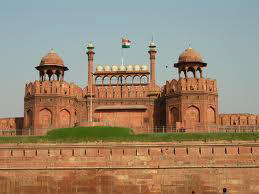 Fort: Also known as The Lal Quila (Lal = red Quila = fort), stands
on the banks of Yamuna. It is surrounded by a perimeter wall of
about 2.4 Kilometers and is built of Red Sandstone. The Mughal
king Shah Jahan (who also built the Taj Mahal) transferred his
capital from Agra to Delhi and the fort was completed in 1648,
nine years after the king shifted to this city. The fort has two
main entrances, the Delhi Gate and the Lahori Gate which faces the
famed Chandni Chowk market.
Fort: Also known as The Lal Quila (Lal = red Quila = fort), stands
on the banks of Yamuna. It is surrounded by a perimeter wall of
about 2.4 Kilometers and is built of Red Sandstone. The Mughal
king Shah Jahan (who also built the Taj Mahal) transferred his
capital from Agra to Delhi and the fort was completed in 1648,
nine years after the king shifted to this city. The fort has two
main entrances, the Delhi Gate and the Lahori Gate which faces the
famed Chandni Chowk market.
Purana Qila
Pandavas had built their capital, Indraprastha at the place where
the old fort stands today. This fort, now in ruins, was the seat
for administration for many emperors. The legendary Prithviraj
Chauhan ruled from here till he was defeated by Abdali in the
battle of Panipat. A new light & sound show is held by the
Department of Delhi Tourism every evening. Timings and Tickets are
available from the tourist office.
Qutab Minar
It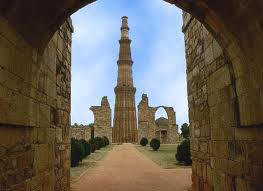 was built by a muslim king, Qutub - ud - din in 1199 AD and a part
of which he could not finish was completed by Itutmish, another
Muslim king. It is situated in the southern part of the capital.
The height of the tower is about 72.5 meter high and there is a
mosque at its base. In front the Qutub Minar there is an iron
pillar which is believed that it was built in 5th century. The
uniqueness part of the pillar is that it has not rusted ever since
it was built. Due to some precaution the Tourists are not allowed
to climb the Qutub Minar i.e. to the tower.
was built by a muslim king, Qutub - ud - din in 1199 AD and a part
of which he could not finish was completed by Itutmish, another
Muslim king. It is situated in the southern part of the capital.
The height of the tower is about 72.5 meter high and there is a
mosque at its base. In front the Qutub Minar there is an iron
pillar which is believed that it was built in 5th century. The
uniqueness part of the pillar is that it has not rusted ever since
it was built. Due to some precaution the Tourists are not allowed
to climb the Qutub Minar i.e. to the tower.
Safdarjung's Tomb
Safdarjung tomb is besides the Safdarjung airport. This tomb was
built by the Nawab of Avadh for his father. The structure is one
of the finest example of architecture of its time and tells the
saga of a dying empire
India Gate
 Primarily
a memorial to the unknown soldier was designed by Lutyens. The 42
meter high structure is a war memorial in honor of the soldiers
who died during the second world war. The imposing structure from
where stretch massive lush green lawns has an eternal flame (Amar
Jawan Jyoti) to honor the memory of the unknown soldiers. India
Gate prominently located in the vicinity of Rashtrapati Bhavan is
a major crowd puller during the hot summer evenings of Delhi by
virtue of its lush green lawns. Primarily
a memorial to the unknown soldier was designed by Lutyens. The 42
meter high structure is a war memorial in honor of the soldiers
who died during the second world war. The imposing structure from
where stretch massive lush green lawns has an eternal flame (Amar
Jawan Jyoti) to honor the memory of the unknown soldiers. India
Gate prominently located in the vicinity of Rashtrapati Bhavan is
a major crowd puller during the hot summer evenings of Delhi by
virtue of its lush green lawns.
Lotus Temple
Completed in 1986, the Bahai temple is set am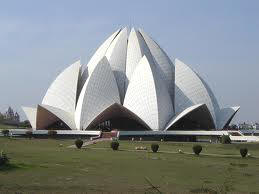 idst
pools and gardens, and adherents of any faith are free to visit
the temple and pray or meditate silently according to their own
religion. The structure is in lotus shape so it often called the
lotus temple. The view of the temple is very spectacular just
before dusk when the temple is flood lit. idst
pools and gardens, and adherents of any faith are free to visit
the temple and pray or meditate silently according to their own
religion. The structure is in lotus shape so it often called the
lotus temple. The view of the temple is very spectacular just
before dusk when the temple is flood lit.
Rashtrapati Bhavan
The house that houses the President of India and the house that
boasts of having welcomed the most powerful men in history. The
Rashtrapati Bhavan was designed by Edwin Lutyens and built in
1931, to be the central point of the British power in Delhi.
Originally called the Viceroy's House, the Rashtrapati Bhavan
covers an area of 4.5 acres of land. It has 340 rooms, 37 salons,
74 lobbies and loggias, 18 staircases and 37 fountains. The most
magnificent room in the Rashtrapati Bhavan is the Durbar Hall,
which lies directly beneath the main dome. All important Indian
State and Official ceremonies are held here. To the west, is the
famous and beautifully landscaped Mughal Gardens, designed after
the terraced gardens the Mughals built in Kashmir. The garden is
famous as the 'Butterfly Garden' for the numerous butterflies that
visit the varied flowers. The garden is open to the public in
February.
Parliament House
Parliament House accommodates the two Houses of Parliament, Lok
Sabha (House of the People) and Rajya Sabha (Council of States).
Sir Edwin Lutyens and Sir Herbert Baker, the architects of New
Delhi, designed this building. His Royal Highness, the Duke of
Connaught, laid the foundation stone of Parliament House in the
year 1921. It took six years to complete the Delhi Parliament
House and its was inaugurated in the year 1927 by the then
Governor-General of India, Lord Irwin. A circular building, it
also houses ministerial offices, a number of committee rooms and a
brilliant library.
The Rajya Sabha and Lok Sabha meetings are held in the domed
circular central hall and the three semi-circular buildings.
Sansad Bhavan of New is adorned with an open verandah with 144
columns and a 28 m central dome. Made up of blocks of sandstone,
it has a diameter of approximately 174 m. Enclosing the Parliament
House Estate is an attractive red sandstone wall or iron grill
with iron gates. It is necessary to take prior permission before
visiting the Parliament House of Delhi. Indians need to get
permission by applying at the Parliament Secretariat and
foreigners through their Embassies or High Commissions
Humayun's Tomb
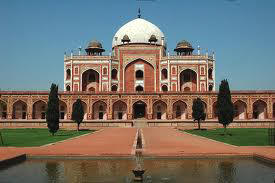 Built
by the wife of Humayun, Haji Begum in the mid 16th century, this
red sand stone structure is considered to be the predecessor of
Taj Mahal. The structure is one of the best example of Mughal
Architecture. Humayun's wife is also buried in the red and white
sandstone, black and yellow marble tomb. The entry in the complex
is free on Fridays. Built
by the wife of Humayun, Haji Begum in the mid 16th century, this
red sand stone structure is considered to be the predecessor of
Taj Mahal. The structure is one of the best example of Mughal
Architecture. Humayun's wife is also buried in the red and white
sandstone, black and yellow marble tomb. The entry in the complex
is free on Fridays.
Rajghat
The simple square platform of black marble on the banks of the
river Yamuna marks the place where Mahatma Gandhi was cremated.
His last words 'Hey Ram' are inscribed on this platform which is
surrounded by a serene garden.
Jamma Masjid
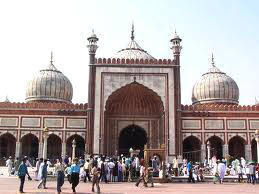 One
of the Architectural gift given by Shah Jahan (who built Taj Mahal),
Jama Masjid is one of the largest mosques not only in Delhi but in
India. Completed in 1658 this Mosque has three gateways, Four
angle towers and two 40 m high minarets. You can enter the mosque
but take precaution to take off your shoes and make sure that you
are properly dressed before entering. One can also go to the top
of minarets. From here you can have a birds eye view of Delhi. One
of the Architectural gift given by Shah Jahan (who built Taj Mahal),
Jama Masjid is one of the largest mosques not only in Delhi but in
India. Completed in 1658 this Mosque has three gateways, Four
angle towers and two 40 m high minarets. You can enter the mosque
but take precaution to take off your shoes and make sure that you
are properly dressed before entering. One can also go to the top
of minarets. From here you can have a birds eye view of Delhi.
Jantar Mantar
Set within the a garden of stately palms, it was built by Maharaja
Jai Singh of Jaipur in 1719. He had been entrusted with the task
of revising the calendar and correcting the astronomical tables
then in use. He made daily astral observation for seven years
before embarking on these stone constructions. He discarded the
usual instruments of brass and built these massive ones in masonry
which are used to the movements of stars. This observatory,
together with the one at Jaipur, are the finest examples anywhere
of observatories modeled on the general pattern laid down by Ulugh
Baigh of Samarkand in the 14th century. The observatory is
conceived with perfect stability and is adjusted to the meridian
and latitude of the location.
Temples of Delhi
LAXMINARAYAN TEMPLE (Birla Temple )
Laxminarayan Temple as viewed from the street The Laxminarayan
Temple, (also called the Birla Mandir), in Delhi, India, is a
temple built in honor of the Hindu goddess of wealth, Laxmi, and
of her consort, Lord Vishnu – the Preserver of the Hindu Trinity.
It is a temple with many shrines, fountains, and a large garden .
The temple attracts thousands of devotees on Janmashtami day, the
birthday of Lord Krishna.
The famous Birla temple patronized by Mahatma Gandhi, who
inaugurated this temple in 1938 after Raja Baldev Birla
constructed it, is dedicated to Goddess Lakshmi. It is close to
Connaught Place and is frequented by many devotees regularly. The
temple was inaugurated by Mahatma Gandhi on the condition that
people of all strata of society be allowed to offer prayers there
on account of the large scale prevalence of untouchability at that
time. One of the most important festivals of the Hindus
Janamashtami coinciding with the birth of Lord Krishna is
celebrated with great fervour in the temple with more.
ISKCON TEMPLE
Built as recently as 1998, the ISKCON temple complex at Hari
Krishna Hill in East of Kailash is one of the most lavish and
grand temples of Delhi. A fine example of architecture, it sports
'Shikharas' rising to a height of 90-ft above ground level and
centrally air-conditioned hall that can hold as many as 1,500
people at once. The fine art paintings by Russian artists here
depict lives and events related to Hindu mythological characters
such as Radha-Krishna, Sita-Ram, Laxman, Hanuman and Chaitanya
Mahaprabhu. Special sermons and prayer meeting are held in the
temple, every Sunday afternoon. Dedicated mainly to Lord Krishna,
the elegant temple was built by the followers of 'Hare-Rama
Hare-Krishna' cult. One of the largest temple complexes in India,
it also boasts of a Robot, which was built especially to enact and
preach 'Gita'. The temple remains opened every day from 4.30 am to
noontime and from 4.00 pm to 9.00 pm
AKSHARDHAM TEMPLE
Akshardham means the eternal, divine abode of the supreme God, the
abode of eternal values and virtues of Akshar as defined in the
Vedas and Upanishads where divine bhakti, purity and peace forever
pervades.
Swaminarayan Akshardham reflects the essence and magnitude of
India's ancient architecture, traditions and timeless
spirituality.
The beautiful monument built without steel, consists of 234
ornately carved pillars, 9 ornate domes, 20 quadrangled shikhars,
a spectacular Gajendra Pith (plinth of stone elephants) and 20,000
murtis and statues of India’s great sadhus, devotees, acharyas and
divine personalities.
The monument is a fusion of pink stone and pure white marble,
where pink stone symbolizes bhakti in eternal bloom and white
marble that of absolute purity and eternal peace. Akshardham was
created by HDH Pramukh Swami Maharaj in fulfillment to the wish of
his guru, Brahmaswarup Yogiji Maharaj, the fourth successor in the
spiritual hierarchy of Bhagwan Swaminarayan. In only a short
timespan of five years Swaminarayan Akshardham became a reality
through the blessings of Pramukh Swami Maharaj, 300 million man
hours of epic services rendered by 11,000 volunteers, sadhus and
artisans and the immense sacrifice, austerities, prayers of
hundreds of thousands of young and old devotees of BAPS
Swaminarayan Sanstha. |